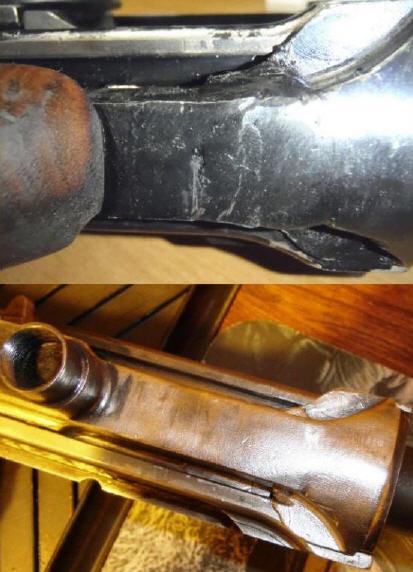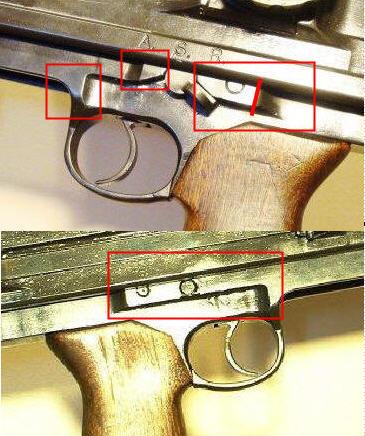-
It's a question that I and many others, including Skippy and Tankie have asked ourselves for many years. It was the only machine gun that was suitable for jungle fighting too. Belts and excess weight are not condusive to the jungle.
I shoot one occasionally just to savour the moment...............
-
-
04-11-2011 08:43 AM
# ADS
Friends and Sponsors

-
FREE MEMBER
NO Posting or PM's Allowed

Yeah. Have to catch a friend of mine in Oregon on a good day to shoot full auto. He had Brought a BREN, MG 42, and MG34 to the range the last time we decided to shoot alot of money(read ammo) down range. Feel bad for folks who don't have access to full auto, its better than Viagra...LOL
-
-
Legacy Member

It's a question that I and many others, including Skippy and Tankie have asked ourselves for many years. It was the only machine gun that was suitable for jungle fighting too. Belts and excess weight are not condusive to the jungle.
Peter, I call the Madness of declaring Obsolete from Service that Works well, Progress with a LARGE Question Mark!.....
I can only assume from a Basic level that with the M.O.Ds stance on a seemingly correct level. Of keeping as many items in Service at a point of Commonality. IE: Most weapons of a Similar Calibre to ease things from a logistic point of view. Also reducing expenditure on a Myriad of spare parts/ componants held in Storage Etc. This would SEEM on the surface to make sense. BUT, the smaller calibre & more frailty of the More Modern Small Arms in Service today. Negates this trend forward! 7.62mm WILL knock down walls with repeated bursts in the same area. 5.56mm Will NOT, & is easily deflected at longer ranges by tree branchs Etc. Im not going to get into a complicated level here on Balisitics & the like. BUT, 7.62mm IS a superb round for most jobs on the field of Combat. The LMG series was extremly robust for just about any job you could think of. But Smallarms do go round in circles like Fashion does. Just look at the .50" Cal Browning HMG. The M.O.D NOW like it sooooo much. They have rotated ALL of thier old refurbed stocks of EX WWII manufactured guns. & now in Service are brand new QCB versions! & at £12,000 a gun. I cant see how that is saving money either from an argumant point of view. But Hey. Governments are famous for their 'Thriftyness' of saving Pennies & Wasting Thousands!..................
Last edited by tankhunter; 04-12-2011 at 04:41 AM.
-
-
Legacy Member

You had to have “hand skills” to work on and repair,…… yes repair!!!!!! These “old” pieces of equipment.
Hand skills are expensive to teach and there are many that do not make the grade ( a high fail rate for armourers,, that were in short supply)
I have changed many parts on the new weapons but rarely do I “repair” them …. Anyone with little training can change parts.
(and I have seen many “tradesmen” change everything until the fault was cured, If they had the training/experience a couple of strokes of a file would have repaired the equipment!!!!!!!)
old yes
twisted yes
bitter yes please
but always happy
-
-
FREE MEMBER
NO Posting or PM's Allowed

Great photos. Just bought myself a mk1m at Chatham at the weekend. Wish it looked half as good as this
-
Advisory Panel



Originally Posted by
Brit plumber

The lower is from a Lithgow gun rather than a Inglis gun and with that type of DP marking and the white paint I'd guesstimate this gun has seen some service in
Australia
and was rejected and DPd in the 1950s FTR programme.
I believe the lower is an early Canadian lower. The extra fins at the back seem to have been deleted earlier in production than the mk1M. I will have to watch the few remaining guns I have left to confirm the serial numbers of that style a lower. I have seen a number of these lowers, and all Cdn marked.
lower. The extra fins at the back seem to have been deleted earlier in production than the mk1M. I will have to watch the few remaining guns I have left to confirm the serial numbers of that style a lower. I have seen a number of these lowers, and all Cdn marked.
This gun came from a local source, and was released out of Canadian service as a cut up. A local machinist reassembled a number of them back in the early 90s as dewats. He intentionally made the bodies shorter so the hammer on the piston group would not make it to the firing pin. He retained about 15 or 20 in his collection. These were recently released for sale.
I have had more than a few of these pass over my workbench for clean-up over the last decade or so. The source for the kits has now dried up.Many of the cut ups in this area were of the early mk1 and mk1m guns. I have found some very early examples from these kits, including a mk1m transitional gun as well as several in the first few hundred of production. Of all these Brens I have seen only 1 BSA marked lower and two BSA mk1 bipods. Everything else has been purely JI Canadian.
The white bands on the guns shown on Clark's gun are fairly typical of the Cdn DP brens, although the guy who did the rewelding on these often would repaint the band to disguise some of the welding and to visually re-align some of the shortened parts like the forward section/barrels.
Last edited by stencollector; 04-25-2011 at 11:35 AM.
-
-
Legacy Member


Originally Posted by
stencollector

I believe the lower is an early
Canadian
lower. The extra fins at the back seem to have been deleted earlier in production than the mk1M. I will have to watch the few remaining guns I have left to confirm the serial numbers of that style a lower. I have seen a number of these lowers, and all Cdn marked.
I'm about 99% sure its a aussie lower, I know of a late intermediate gun with matching lower which is the same as the early Enfield and Inglis type, and I know of a Mk1m in the M5100 range which has a matching Mk1m type leaving only a few hundred to have another variation. Lithgow is the only producer i've seen of this type, which has the lightning cuts but dosn't have the shaped portion around the selector etc. as per early Enfield and inglis guns.
is the only producer i've seen of this type, which has the lightning cuts but dosn't have the shaped portion around the selector etc. as per early Enfield and inglis guns.

-
-
Legacy Member

Well the comments regarding the lower/sliding butt group got my curiousity going so hope you don't mind me poking my nose in ?
I have not come across a variation that envelopes all the machining as per Clarks pic , but this is only my limited observations.
I hope that someone else has got or has seen a variation that meets all the criteria or that Clark can answer a question that may help matters ?
I can find Inglis and Enfield lower butt groups that match the machining to the area either side of the selector lever/trigger axis pin but not with the early lightened end to the butt group.
Going back to Clarks pics it 'looks' as though another 'rear end' may have been welded on ?

If so this may explain allot.......can you enlighten me Clark ?
I have high lighted the key points that I can only find on Inglis and Enfield MKIm sliding butt groups but of course the do not have the lightened MKI rear ?

Has a lightened rear been welded on ? Or has anyone got an exact match including a lightened rear ?
ATB Kevin
-
-
Legacy Member

Yes... and its marked MA... Lithgow I presume.
I presume.
-
-
Advisory Panel


The guns that were assembled from the local parts source were never intentionally matched up. Mk1, mk1m, mk2 all would be pieced back together in one unit. The guy who put these together even mixed upper receiver portions, putting mk2 front portions onto mk1 or mk1m receivers. He also used up all the mk2 bipods onto these guns, leaving all mk1 bipods to go with the remaining mk2 parts kits.
The pile of old bren transit crates from the source of these kits is about the size of a car garage. They have been sitting outside since the 60s, and the pile is now collapsing onto itself as some of the crates disintegrate from rot. There were a lot of these guns released in this manner.
-
Thank You to stencollector For This Useful Post:
















 PM
PM













